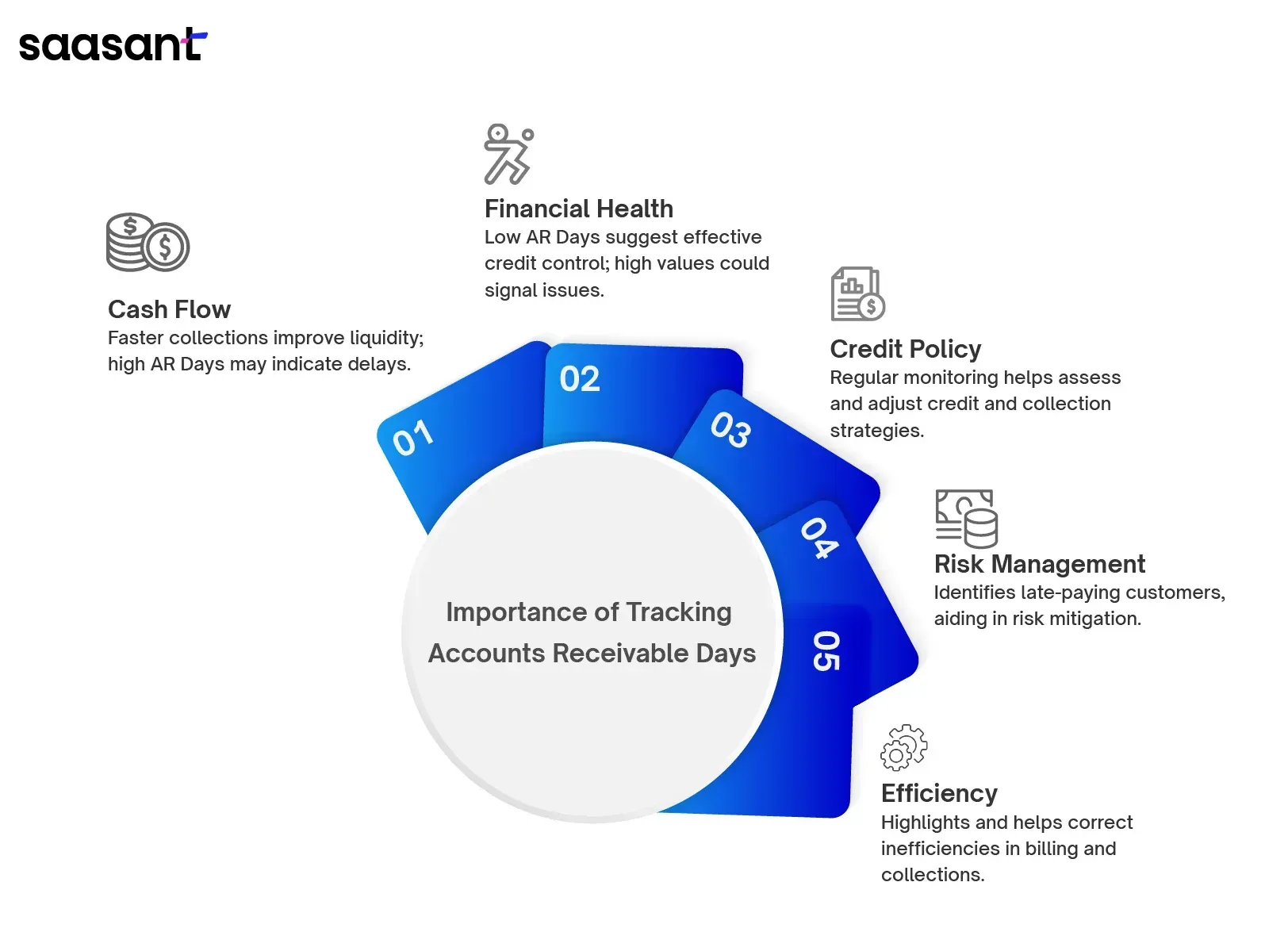Accounts Receivable Days: Definition, Formula, and Optimization Strategies
 Understanding and managing cash flow is crucial for any business. One key metric that can significantly impact a business's financial health is Accounts Receivable Days (AR Days). This metric reveals the average days a company takes to collect customer payments. Knowing how to calculate and interpret AR Days can help businesses improve their cash flow, reduce the risk of bad debts, and enhance overall financial stability.
Understanding and managing cash flow is crucial for any business. One key metric that can significantly impact a business's financial health is Accounts Receivable Days (AR Days). This metric reveals the average days a company takes to collect customer payments. Knowing how to calculate and interpret AR Days can help businesses improve their cash flow, reduce the risk of bad debts, and enhance overall financial stability.
This blog will further walk you through the account receivable definition, formula and optimization strategies.
Contents
What Is Accounts Receivable Days?
Importance of Tracking Accounts Receivable Days
How to Calculate Accounts Receivable Days
Interpreting Accounts Receivable Days
Strategies to Optimize Accounts Receivable Days
Conclusion
FAQ’s
What Is Accounts Receivable Days?
Accounts Receivable Days (AR Days) is a financial metric businesses use to measure the average number of days it takes to collect payment after a sale has been made on credit. It provides insight into the effectiveness of a company's credit and collections policies and indicates how quickly customers pay their invoices.
This metric is particularly important because it affects a company’s cash flow. A lower AR Days value means that a company is collecting payments faster, which is beneficial for maintaining a healthy cash balance.
By monitoring and managing AR Days, businesses can better plan their finances, identify issues with specific customers, and take necessary actions to improve their overall financial stability.
Importance of Tracking Accounts Receivable Days
Tracking Accounts Receivable Days is essential for any business that extends credit to its customers. It is a key indicator of the company's credit policies and collection efforts. Here’s why understanding and managing this metric is crucial:

Cash Flow Management:
The quicker a company collects its receivables, the faster it can turn sales into cash. This liquidity is important for covering operational costs and investing in growth opportunities. High Accounts Receivable Days may indicate slower cash inflows, which could strain the company's ability to meet its financial obligations.
Financial Health and Viability:
A lower AR Days figure often reflects a robust credit control system and collections process, which indicates good financial health. In contrast, a high AR Days value may signal potential problems, such as customer dissatisfaction, ineffective collection processes, or issues with payment terms, which could compromise financial stability.
Credit Policy Assessment:
By monitoring AR Days, businesses can evaluate the importance of their credit policies. If the AR Days metric is consistently high, it might be time to reassess the payment terms offered to customers or the procedures used to collect payments.
Risk Reduction:
Understanding AR Days' patterns and trends helps identify risky customers who consistently pay late. This can guide businesses in adjusting credit limits or terms for specific customers to avoid risk.
Operational Efficiency:
Regularly tracking this metric can highlight inefficiencies in the billing and collections processes. Improving these can lead to quicker collections, fewer AR Days, and enhanced operational efficiency.
How to Calculate Accounts Receivable Days
To calculate Accounts Receivable Days, first calculate the accounts receivable turnover ratio and then use the receivable days formula:
Accounts Receivable Turnover Ratio:
Formula: Accounts Receivable Turnover Ratio = Total Credit Sales / Average Accounts Receivable Balance
Accounts Receivable Days Formula:
Formula: Accounts Receivable Days = (Accounts Receivable / Total Credit Sales) x Number of Days in the Period
Example Calculation:
For Company X, with an annual revenue of $5 million and accounts receivable standing at $500,000, the calculation is as follows:
Total Revenue = $5,000,000
Accounts Receivable = $500,000
Accounts Receivable Days Formula: Accounts Receivable Days = (Accounts Receivable / Total Revenue) * 365
= (500,000 / 5,000,000) * 365
= 0.1 * 365 = 36.5 days
Therefore, Company X's Accounts Receivable Days are 36.5 days.
Interpreting Accounts Receivable Days
Interpreting Accounts Receivable Days involves analyzing how quickly a business collects payments after a sale, providing crucial insights into its cash flow efficiency and financial stability.
High vs. Low Accounts Receivable Days
A low Accounts Receivable Days value indicates that a company efficiently collects customer payments shortly after a sale. This efficiency boosts cash flow, minimizes non-payment risk, and reduces the need for excessive borrowing to cover operational costs.
Conversely, a high Accounts Receivable Days figure suggests that a company takes longer to collect its debts. This can tie up capital in receivables and potentially lead to cash flow problems, affecting the company's ability to pay its obligations on time. Additionally, longer collection periods can increase the likelihood of debts becoming uncollectable.
Benchmarking Against Industry Standards
To interpret Accounts Receivable Days effectively, it's crucial to compare your metrics against industry averages. Different industries have varying typical credit terms and payment cycles. For instance, industries like construction or heavy machinery might have higher AR Days due to longer project durations and billing cycles than retail businesses.
By benchmarking against industry standards, businesses can identify whether their credit and collections processes are competitive, overly lenient, or too restrictive. If your AR Days are significantly higher than the industry average, it might be a sign that you need to reassess your credit policies or improve your collection practices. Conversely, AR Days significantly lower than the industry average could indicate overly strict credit policies that might limit sales opportunities.
Using industry benchmarks helps businesses set realistic goals for improving their collections processes and making strategic decisions that align with industry practices, enhancing overall financial health and operational efficiency.
Strategies to Optimize Accounts Receivable Days
Strategies to optimise Accounts Receivable Days focus on implementing best practices in receivables management, tips for improving credit policies, and accurate invoicing.

Best Practices for Accounts Receivable Management
Optimising Accounts Receivable Days starts with implementing best practices that streamline and enforce your receivables process. Key strategies include:
Monitor the age of your receivables regularly to identify late payments early and address them promptly.
Establish and communicate clear credit terms to customers upfront and ensure they are understood and agreed upon.
Use automated systems to send reminders to customers about upcoming and overdue payments, reducing the manual workload and ensuring timely follow-ups.
Accepting multiple forms of payment, including digital and mobile payment options, will increase customers' ease of payment.
Regularly perform credit checks on new and existing customers to assess their creditworthiness and adjust credit terms accordingly.
Tips for Improving Credit Policies
Improving your credit policies is crucial for reducing AR Days and maintaining healthy cash flows:
Implement tiered credit levels based on customer payment history and creditworthiness to minimize risk.
Regularly review and adjust credit limits and terms based on ongoing customer performance and broader economic conditions.
Enforce credit policies strictly and consistently to prevent exceptions that could undermine your collections efforts.
Consider offering discounts for early payments to encourage quicker settlement of invoices.
Importance of Timely Invoicing and Collections
The efficiency of your invoicing and collections processes directly influences your AR Days:
Issue invoices immediately after delivery of goods or services to avoid delays in payment initiation.
Ensure invoices are accurate and include all necessary details to prevent delays due to customer queries.
Maintain a proactive collections team that engages with customers before payments are due, fostering good relationships and encouraging timely payments.
Train your team on new tools, technologies, and techniques for effective receivables management to optimize your processes.
Conclusion
Understanding and managing Accounts Receivable Days is essential for maintaining a healthy cash flow and ensuring a business's financial stability. This metric highlights the effectiveness of a company's credit and collection policies and indicates how efficiently a business can convert sales into actual cash.
By implementing strategic practices such as improving credit policies, simplifying invoicing procedures, and enhancing collection efforts, companies can significantly reduce the time it takes to receive payments.
FAQ’s
What Are Accounts Receivable Days?
Accounts Receivable Days is a financial metric that measures the average number of days it takes for a business to collect payments after a sale has been made on credit. It provides insights into the efficiency of a company’s credit and collections processes.
How do you calculate accounts receivable days?
Accounts Receivable Days are calculated using the formula:
Accounts Receivable Days = ( Accounts Receivable / Total Credit Sales) × Number of Days. This formula measures the average time to turn receivables into cash over a year, typically a year.
How many days do you need to collect accounts receivable?
The number of days needed to collect accounts receivable varies by industry and individual company policies. Shorter collection periods are generally preferred to indicate more efficient cash flow management. The specific target or acceptable range can be benchmarked against industry standards.
Why are accounts receivable days important?
Accounts Receivable Days are important because they indicate how quickly a company collects cash from its credit sales. Efficient collection impacts a company’s liquidity, reduces the risk of bad debts, and enhances overall financial health.
What is a good number of accounts receivable days?
The number of Accounts Receivable Days depends on the industry and the payment terms set by the company. Typically, fewer days are considered better, indicating a faster collection of receivables. Companies should aim at or better than their industry average to ensure competitive financial operations.
How can I improve my accounts receivable days?
Several strategies can improve accounts receivable days, including improving credit policies, offering early payment incentives, using automated billing and reminders, conducting regular customer credit reviews, and maintaining proactive communication with customers about their payment status. These methods help reduce the day's sales outstanding and improve the company's cash flow.